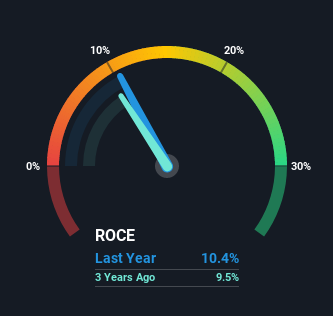Here's What To Make Of Kingfisher's (LON:KGF) Decelerating Rates Of Return
What are the early trends we should look for to identify a stock that could multiply in value over the long term? Typically, we'll want to notice a trend of growing return on capital employed (ROCE) and alongside that, an expanding base of capital employed. Ultimately, this demonstrates that it's a business that is reinvesting profits at increasing rates of return. So, when we ran our eye over Kingfisher's (LON:KGF) trend of ROCE, we liked what we saw.
What is Return On Capital Employed (ROCE)?
For those that aren't sure what ROCE is, it measures the amount of pre-tax profits a company can generate from the capital employed in its business. Analysts use this formula to calculate it for Kingfisher:
Return on Capital Employed = Earnings Before Interest and Tax (EBIT) ÷ (Total Assets - Current Liabilities)
0.10 = UK£946m ÷ (UK£12b - UK£3.2b) (Based on the trailing twelve months to January 2021).
Therefore, Kingfisher has an ROCE of 10%. By itself that's a normal return on capital and it's in line with the industry's average returns of 10%.
Check out our latest analysis for Kingfisher
In the above chart we have measured Kingfisher's prior ROCE against its prior performance, but the future is arguably more important. If you'd like to see what analysts are forecasting going forward, you should check out our free report for Kingfisher.
How Are Returns Trending?
While the current returns on capital are decent, they haven't changed much. The company has employed 29% more capital in the last five years, and the returns on that capital have remained stable at 10%. Since 10% is a moderate ROCE though, it's good to see a business can continue to reinvest at these decent rates of return. Stable returns in this ballpark can be unexciting, but if they can be maintained over the long run, they often provide nice rewards to shareholders.
The Bottom Line On Kingfisher's ROCE
The main thing to remember is that Kingfisher has proven its ability to continually reinvest at respectable rates of return. And given the stock has only risen 30% over the last five years, we'd suspect the market is beginning to recognize these trends. So because of the trends we're seeing, we'd recommend looking further into this stock to see if it has the makings of a multi-bagger.
One more thing, we've spotted 1 warning sign facing Kingfisher that you might find interesting.
While Kingfisher isn't earning the highest return, check out this free list of companies that are earning high returns on equity with solid balance sheets.
This article by Simply Wall St is general in nature. It does not constitute a recommendation to buy or sell any stock, and does not take account of your objectives, or your financial situation. We aim to bring you long-term focused analysis driven by fundamental data. Note that our analysis may not factor in the latest price-sensitive company announcements or qualitative material. Simply Wall St has no position in any stocks mentioned.
Have feedback on this article? Concerned about the content? Get in touch with us directly. Alternatively, email editorial-team (at) simplywallst.com.

 Yahoo Finance
Yahoo Finance 
